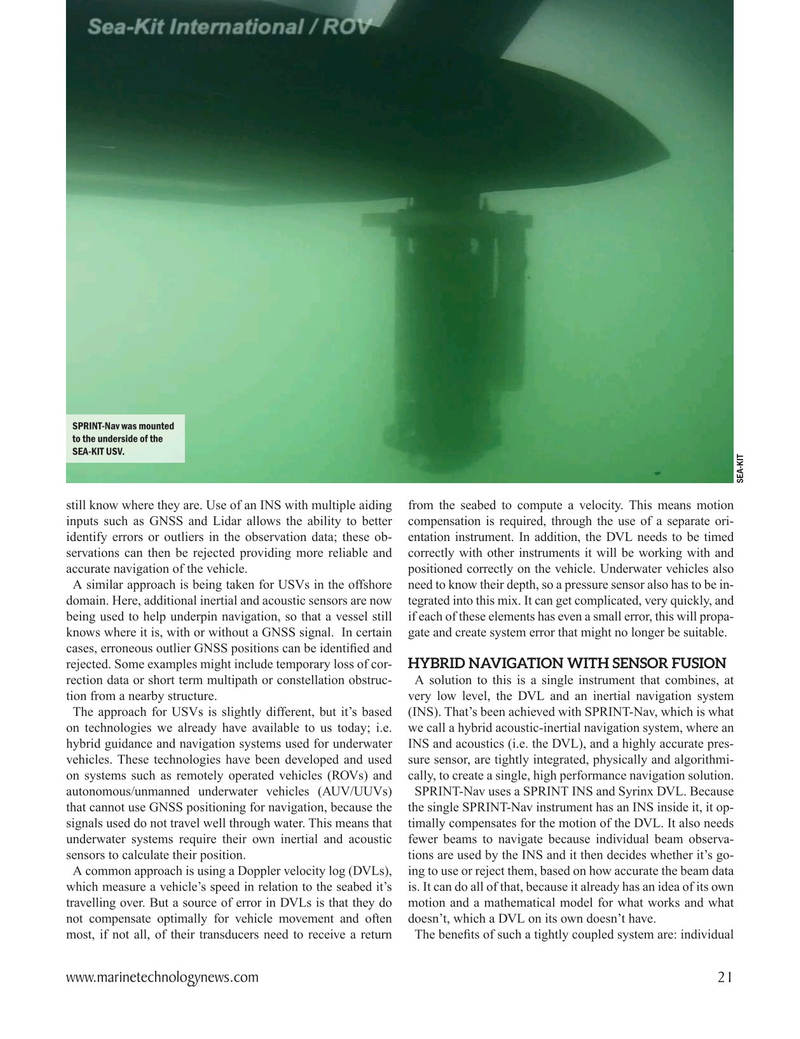
Page 21: of Marine Technology Magazine (January 2021)
Underwater Vehicle Annual
Read this page in Pdf, Flash or Html5 edition of January 2021 Marine Technology Magazine
SPRINT-Nav was mounted to the underside of the
SEA-KIT USV.
SEA-KIT still know where they are. Use of an INS with multiple aiding from the seabed to compute a velocity. This means motion inputs such as GNSS and Lidar allows the ability to better compensation is required, through the use of a separate ori- identify errors or outliers in the observation data; these ob- entation instrument. In addition, the DVL needs to be timed servations can then be rejected providing more reliable and correctly with other instruments it will be working with and accurate navigation of the vehicle. positioned correctly on the vehicle. Underwater vehicles also
A similar approach is being taken for USVs in the offshore need to know their depth, so a pressure sensor also has to be in- domain. Here, additional inertial and acoustic sensors are now tegrated into this mix. It can get complicated, very quickly, and being used to help underpin navigation, so that a vessel still if each of these elements has even a small error, this will propa- knows where it is, with or without a GNSS signal. In certain gate and create system error that might no longer be suitable. cases, erroneous outlier GNSS positions can be identi? ed and rejected. Some examples might include temporary loss of cor- HYBRID NAVIGATION WITH SENSOR FUSION rection data or short term multipath or constellation obstruc- A solution to this is a single instrument that combines, at tion from a nearby structure. very low level, the DVL and an inertial navigation system
The approach for USVs is slightly different, but it’s based (INS). That’s been achieved with SPRINT-Nav, which is what on technologies we already have available to us today; i.e. we call a hybrid acoustic-inertial navigation system, where an hybrid guidance and navigation systems used for underwater INS and acoustics (i.e. the DVL), and a highly accurate pres- vehicles. These technologies have been developed and used sure sensor, are tightly integrated, physically and algorithmi- on systems such as remotely operated vehicles (ROVs) and cally, to create a single, high performance navigation solution. autonomous/unmanned underwater vehicles (AUV/UUVs) SPRINT-Nav uses a SPRINT INS and Syrinx DVL. Because that cannot use GNSS positioning for navigation, because the the single SPRINT-Nav instrument has an INS inside it, it op- signals used do not travel well through water. This means that timally compensates for the motion of the DVL. It also needs underwater systems require their own inertial and acoustic fewer beams to navigate because individual beam observa- sensors to calculate their position. tions are used by the INS and it then decides whether it’s go-
A common approach is using a Doppler velocity log (DVLs), ing to use or reject them, based on how accurate the beam data which measure a vehicle’s speed in relation to the seabed it’s is. It can do all of that, because it already has an idea of its own travelling over. But a source of error in DVLs is that they do motion and a mathematical model for what works and what not compensate optimally for vehicle movement and often doesn’t, which a DVL on its own doesn’t have. most, if not all, of their transducers need to receive a return The bene? ts of such a tightly coupled system are: individual www.marinetechnologynews.com 21
MTR #1 (18-33).indd 21 1/25/2021 9:05:12 AM

 20
20

 22
22
